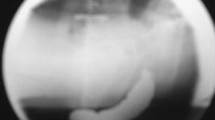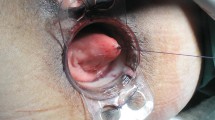Abstract.
The diagnosis of significant rectocele is currently made on the basis of cinedefecographic findings. Clinical examination alone will only allow assessment of the presence but not the significance of a rectocele. Therefore, the aim of this study was to determine if anal manometric findings can predict the significance of a rectocele. All patients with a diagnosis of constipation and rectocele confirmed on cinedefecography between 1992 and 1998 were retrospectively reviewed. Significant rectocele was defined as the presence of three of the following five parameters: rectocele >4 cm in diameter as measured during the evacuatory phase of cinedefecography, rectal and/or vaginal symptoms present for longer than 12 months, persistence of rectal or vaginal symptoms for at least four weeks, despite increased dietary fiber (up to 35 g/day), need for rectal and/or vaginal digitation or perineal support maneuvers for rectal evacuation. Statistical analysis was performed using the Mann-Whitney test and Fisher's exact test. A logistic regression model with stepwise selection was used to determine significant prognostic factors. A total of 305 patients (31 men) with rectocele, with a median age of 68 years (range, 12–89) were identified. Of these, 89 (29.2%) had significant rectoceles. There was no difference in the frequency of significant and non-significant rectoceles with respect to gender or age. However, patients with a significant rectocele compared to those with a non-significant rectocele had higher median first sensation volume (45 vs. 30 ml, p=0.0005), median capacity (160 vs. 120 ml, p<0.0001), and median compliance (10 vs. 8 ml H2O/mmHg, p=0.05). Calculations based on a logistic regression model determined that with a first sensation of 100 ml, a capacity of 400 ml, and a compliance of 50 ml/mmHg, the probability of a significant rectocele would be 85%.In conclusion, anal manometric findings may be useful in predicting significant rectocele in constipated patients.
Similar content being viewed by others
Author information
Authors and Affiliations
Additional information
Received: 12 July 2001 / Accepted: 21 July 2002
Note This work was presented in preliminary form as a poster at the annual meeting of the American Society of Colon and Rectal Surgeons, 24–29 June 2000, Boston, USA.
Correspondence to S. D. Wexner
Rights and permissions
About this article
Cite this article
Rotholtz, N., Efron, J., Weiss, E. et al. Anal manometric predictors of significant rectocele in constipated patients. Tech Coloproctol 6, 73–77 (2002). https://doi.org/10.1007/s101510200016
Issue Date:
DOI: https://doi.org/10.1007/s101510200016




